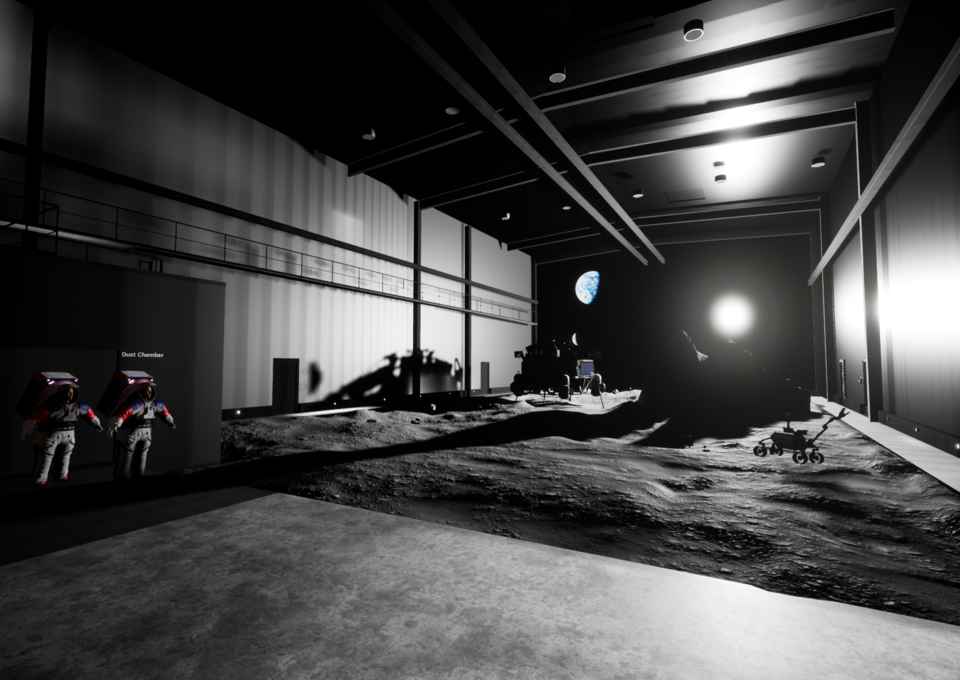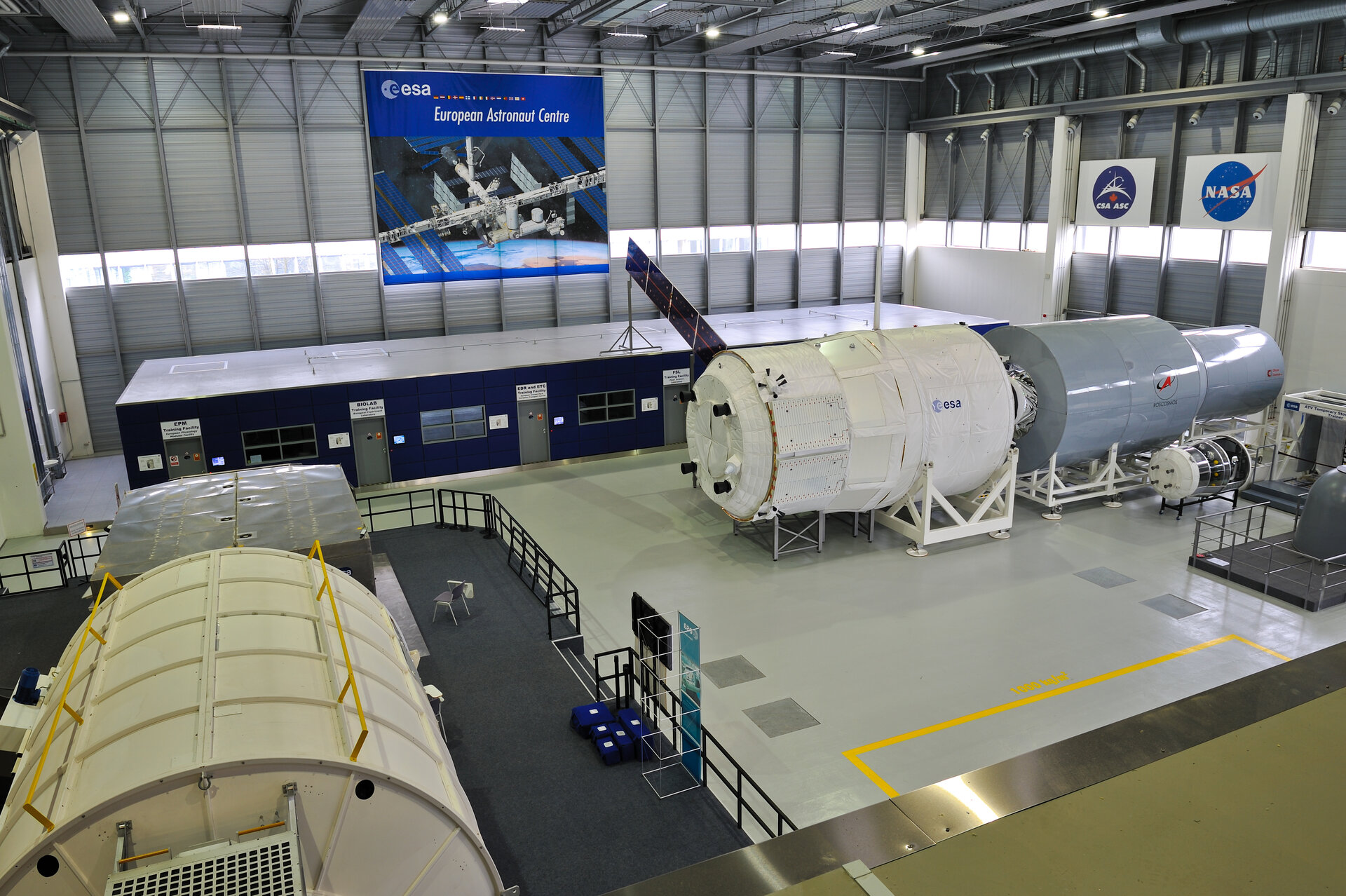The European Astronaut Centre
The European Astronaut Centre (EAC) was established in 1990 and is located in Cologne, Germany. Home to ESA’s astronaut corps, it is the European centre of excellence for astronaut selection, training, and support. The team at EAC equip European and international astronauts with the skills and knowledge they need to fly to the International Space Station (ISS) today while preparing for an exciting future of exploration beyond low Earth orbit.
Led by ESA astronaut Frank de Winne, EAC reinforces Europe's commitment to human and robotic exploration.
For astronauts and ground operations personnel, EAC is the training centre for all European-built ISS hardware, including ESA's Columbus laboratory and European payloads.
It is also home to ESA's Astronaut Operations Team. Specialised European Communicator and Medical Operations (EUROCOM) experts are responsible for all European voice communications with astronauts on the International Space Station. From the control centre at EAC, they work closely with operations teams at ESA’s Columbus Control Centre (Col-CC) in Oberpfaffenhofen, near Munich, Germany, the User Support and Operation Centres (USOCs) and space medicine experts.
The EAC Crew Operations Support (ECOS) is a multidisciplinary team composed of members and operational experts from different EAC teams such as Space Medicine, Space Training and Astronaut Operations.
EAC has established its medical expertise for astronauts including preventive medicine, evidence-based medicine, nutrition and fitness. In addition, the Centre provides public relations assistance for human spaceflight and educational activities, as well as promoting opportunities to industry for commercial experiments.
History

After its foundation in 1990, three ESA astronauts were based at EAC. They were selected in 1978 for the first Spacelab mission on the US Space Shuttle in 1983. ESA stronaut Ulf Merbold (Germany) flew on that mission. Wubbo Ockels (Netherlands) flew on the Spacelab D1 mission in 1985. Claude Nicollier (Switzerland) completed his first mission on Space Shuttle flight STS-46 in 1992. Nicollier participated in three further Shuttle missions in 1993 (STS-61), 1996 (STS-75) and 1999 (STS-103). Nicollier became the first European to perform an Extra Vehicular Activity (EVA, more commonly known as a spacewalk) during a Shuttle mission.
In 1998, ESA member states took the decision to join the forces of the national astronaut teams and to reinforce the European identity through a single European Astronaut Corps, a process, which concluded in 2002 with a Corps of 16 astronauts.
Since the EAC took its first steps, the list of missions completed by European astronauts and supported by the EAC has grown considerably. In spite of the limited access to the ISS during the years 2003 through 2005 due to the Columbia accident, ESA managed to continuously fly ESA astronauts to the International Space Station with the Russian Soyuz spacecraft.
European presence in space and the progress of space research carried out by European institutions and companies could be secured. With the Space Shuttle’s return to flight in 2005, Europe’s engagement in human spaceflight featured historic moments with 2 missions in 2006: Thomas Reiter (Germany) was the first European astronaut participating on a long duration flight as ISS Expedition crew (flight engineer 2 of Expeditions 13 and 14), spending nearly six months on orbit for ISS operations and experiments in weightlessness.
Christer Fuglesang (Sweden) joined Reiter on the ISS on a Shuttle flight in December 2006 for performing important EVA activities. This was the first time in the ISS eight-year history that two Europeans met together on the International Space Station.
2007 saw the beginning of the most intense period of human spaceflight activity in Europe. Paolo Nespoli (Italy) brought the European-built Node 2 connecting module to the ISS on the STS-120 mission in September 2007. The attachment of Node 2 paved the way for the arrival of ESA's cornerstone contribution to the ISS, the Columbus laboratory.

Hans Schlegel (Germany) and Léopold Eyharts (France) brought Columbus to the ISS on the STS-122 mission in February 2008, where it was attached to Node 2. Schlegel participated in one spacewalk during the STS-122 mission and was instrumental in the attachment of Columbus. Eyharts became the first European astronaut to fly a long-term mission on Columbus. During his stay he activated the laboratory and conducted the first experiments from the European microgravity science programme inside Columbus.
That good training pays off was demonstrated with the docking of ATV Jules Verne in April 2008. The ISS crew were trained on ATV docking at EAC before their mission to the Space Station.
In May 2009, EAC selected six new astronauts who started their basic training at EAC on 1 September 2009. Since then, all have completed at least one flight to the International Space Station, including Matthias Maurer, who formally joined ESA’s astronaut corps in 2015 and flew on his first mission in 2021/22.
Current activities

In 2021, ESA opened a call to recruit a new class of European astronauts, the fourth time since 1978. After successfully passing six key stages of the selection process 17 new astronaut candidates were chosen from more than 22 500 applicants from across ESA’s Member States. The last stage saw ESA Director general Josef Aschbacher select five career astronauts, and 12 members of the ESA astronaut reserve, including one candidate to join ESA's feasibility study "Fly!", a project destined to investigate the possibility to assign person with disability to a regular long-term space mission.
ESA’s new astronaut candidates took up duty at EAC and started basic training on 3 April 2023.
After completing one year of basic training, the new astronauts will be ready to enter the next Space Station training phase and, once assigned to a mission, their training will be tailored to specific mission tasks.
In addition to training ESA’s new generation of astronauts, EAC is also a growing training ground for international partners and private astronaut training. In February 2023, EAC could welcome for the second time an Axiom Space crew to be familiarised with ESA systems and activities at EAC for their commercial mission to the International Space Station NET beginning of May 2023.
With the start of Australian Space Agency astronaut candidate Katherine Bennell-Pegg’s basic training together with the ESA astronaut class of 2022, EAC furthermore became one of only three centres in the world to train foreign astronauts and certify completion of basic training according to the international ISS standards.

As we look forward to taking humanity to the Moon with the international lunar exploration programme Artemis, EAC is preparing to train the next generation of lunar explorers on European soil.
Soon, the lunar analogue facility called ESA-DLR LUNA shall be installed opposite of EAC. The collaborative project between the European Space Agency ESA and the German Aerospace Centre DLR will provide a training ground for astronauts and a test centre for technology, equipping partners and users with the knowledge to go forward to the Moon.















 Germany
Germany
 Austria
Austria
 Belgium
Belgium
 Denmark
Denmark
 Spain
Spain
 Estonia
Estonia
 Finland
Finland
 France
France
 Greece
Greece
 Hungary
Hungary
 Ireland
Ireland
 Italy
Italy
 Luxembourg
Luxembourg
 Norway
Norway
 The Netherlands
The Netherlands
 Poland
Poland
 Portugal
Portugal
 Czechia
Czechia
 Romania
Romania
 United Kingdom
United Kingdom
 Slovenia
Slovenia
 Sweden
Sweden
 Switzerland
Switzerland



























